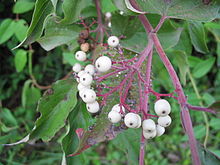Cornus racemosa
| Cornus racemosa | ||||||||||||
|---|---|---|---|---|---|---|---|---|---|---|---|---|

Cornus racemosa , illustration from L'Héritiers Cornus: specimen botanicum ... , there as Cornus paniculata |
||||||||||||
| Systematics | ||||||||||||
|
||||||||||||
| Scientific name | ||||||||||||
| Cornus racemosa | ||||||||||||
| Lam. |
The plant species Cornus racemosa belongs to the genus dogwood ( Cornus ) in the dogwood family (Cornaceae). It is common in the northeastern part of North America and is called "Gray Dogwood" there.
Description, phenology and ecology
Cornus racemosa grows as a deciduous shrub that reaches heights of 1.5 to 4 meters, in exceptional cases up to 8 meters. Its branches are ascending and heavily branched. The bark of young branches is red-brown in color on older ones gray. Extensive thickets can arise at suitable locations through numerous foothills .
The opposite leaves are 6 to 10 centimeters long. The leaves shoot at the beginning of April, the leaves fall at the end of October. The autumn color is a dark carmine red.
The flowering period extends from around May to July. The flowers are grouped in a gold-like inflorescence. The flower stalks are green, they turn bright red until the fruit is ripe. The hermaphrodite flowers are four-fold with a double flower envelope . The four free petals are yellowish-white. The white stone fruit contains a single, more or less spherical stone core. The fruits ripen from around August to October. The fruit is mainly spread by birds, but various mammals also eat it.
The number of chromosomes is 2n = 22.
Occurrence
Cornus racemosa is native to northeastern North America , roughly in a band south of the Great Lakes , from the coast of Maine and New York to the beginning of the prairies .
Cornus racemosa grows there in different locations, in open meadows and forest clearings, on streams, roadsides and forest edges. It is not as tied to moist soil as similar North American dogwoods, such as the silky dogwood ( Cornus sericea ).
Socialized is Cornus racemosa with the diverse tree species of North American forests, particularly oak trees - and maple species, the Hickory and the American linden . It thrives in the undergrowth there very often, together with Viburnum acerifolium and wild grape ( Parthenocissus quinquefolia ).
use
In the natural range, the rapid growth and the rooting runners are used to avoid soil erosion . In Europe, Cornus racemosa is rarely used as an ornamental plant.
swell
- M. Coladonato: Cornus racemosa . In: fs.fed.us. US Department of Agriculture, Forest Service, Missoula Mon 1993.
- USDA "PLANTS Database", photos, distribution map and "Fact Sheet" of the US Department of Agriculture.
Individual evidence
- ↑ Cornus racemosa at Tropicos.org. In: IPCN Chromosome Reports . Missouri Botanical Garden, St. Louis
- ↑ a b Distribution map, US Department of Agriculture (PDF; 739 kB)
Web links
- Cornus racemose ( English ) Virginia Tech. Retrieved August 13, 2013.
- Cornus racemosa ( English ) University of Connecticut. Retrieved August 13, 2013.

